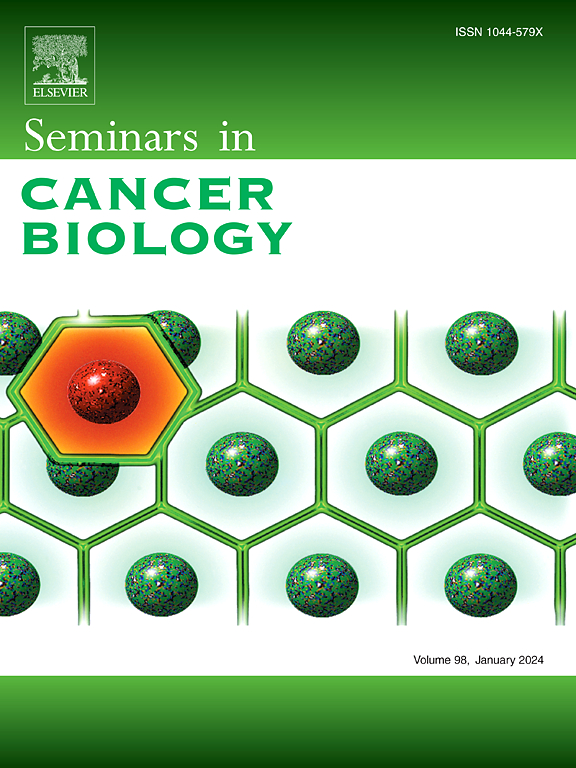BubR1 and SIRT2: Insights into aneuploidy, aging, and cancer
IF 12.1
1区 医学
Q1 ONCOLOGY
引用次数: 0
Abstract
Aging is a significant risk factor for cancer which is due, in part, to heightened genomic instability. Mitotic surveillance proteins such as BubR1 play a pivotal role in ensuring accurate chromosomal segregation and preventing aneuploidy. BubR1 levels have been shown to naturally decline with age and its loss is associated with various age-related pathologies. Sirtuins, a class of NAD+-dependent deacylases, are implicated in cancer and genomic instability. Among them, SIRT2 acts as an upstream regulator of BubR1, offering a critical pathway that can potentially mitigate age-related diseases, including cancer. In this review, we explore BubR1 as a key regulator of cellular processes crucial for aging-related phenotypes. We delve into the intricate mechanisms through which BubR1 influences genomic stability and cellular senescence. Moreover, we highlight the role of NAD+ and SIRT2 in modulating BubR1 expression and function, emphasizing its potential as a therapeutic target. The interaction between BubR1 and SIRT2 not only serves as a fundamental regulatory pathway in cellular homeostasis but also represents a promising avenue for developing targeted therapies against age-related diseases, particularly cancer.
BubR1 和 SIRT2:对非整倍体、衰老和癌症的见解
衰老是癌症的一个重要风险因素,其部分原因是基因组不稳定性增加。BubR1 等有丝分裂监控蛋白在确保染色体准确分离和防止非整倍体方面发挥着关键作用。研究表明,BubR1 的水平会随着年龄的增长而自然下降,它的损失与各种与年龄相关的病症有关。Sirtuins 是一类依赖 NAD+ 的脱酰酶,与癌症和基因组不稳定性有关。其中,SIRT2 是 BubR1 的上游调控因子,提供了一个可能缓解包括癌症在内的老年相关疾病的关键途径。在这篇综述中,我们将探讨 BubR1 作为衰老相关表型关键细胞过程的关键调节因子。我们深入探讨了 BubR1 影响基因组稳定性和细胞衰老的复杂机制。此外,我们还强调了 NAD+ 和 SIRT2 在调节 BubR1 表达和功能方面的作用,并强调了其作为治疗靶点的潜力。BubR1 和 SIRT2 之间的相互作用不仅是细胞稳态的基本调节途径,也是开发抗衰老相关疾病(尤其是癌症)靶向疗法的一个前景广阔的途径。
本文章由计算机程序翻译,如有差异,请以英文原文为准。
求助全文
约1分钟内获得全文
求助全文
来源期刊

Seminars in cancer biology
医学-肿瘤学
CiteScore
26.80
自引率
4.10%
发文量
347
审稿时长
15.1 weeks
期刊介绍:
Seminars in Cancer Biology (YSCBI) is a specialized review journal that focuses on the field of molecular oncology. Its primary objective is to keep scientists up-to-date with the latest developments in this field.
The journal adopts a thematic approach, dedicating each issue to an important topic of interest to cancer biologists. These topics cover a range of research areas, including the underlying genetic and molecular causes of cellular transformation and cancer, as well as the molecular basis of potential therapies.
To ensure the highest quality and expertise, every issue is supervised by a guest editor or editors who are internationally recognized experts in the respective field. Each issue features approximately eight to twelve authoritative invited reviews that cover various aspects of the chosen subject area.
The ultimate goal of each issue of YSCBI is to offer a cohesive, easily comprehensible, and engaging overview of the selected topic. The journal strives to provide scientists with a coordinated and lively examination of the latest developments in the field of molecular oncology.
 求助内容:
求助内容: 应助结果提醒方式:
应助结果提醒方式:


